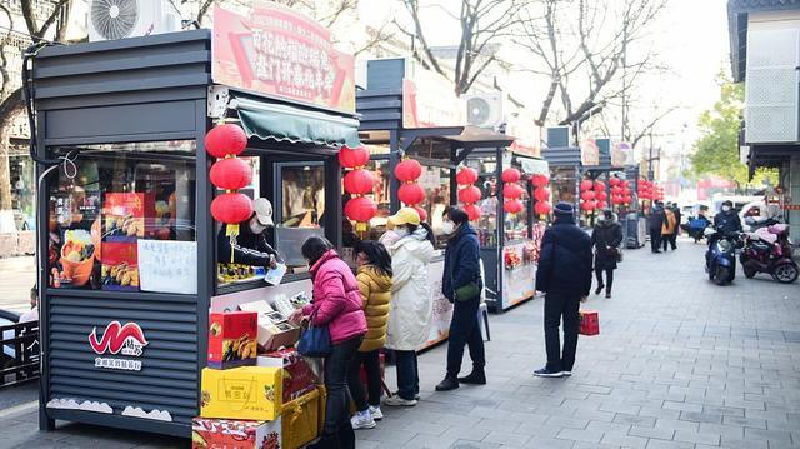China and Covid19
Another Death in Isolation: Hohhot Woman Falls to Death from 12th Floor of Locked-Down Building
What happened in Hohhot? And why did the incident receive nationwide attention? An explainer including timeline.
Published
2 years agoon
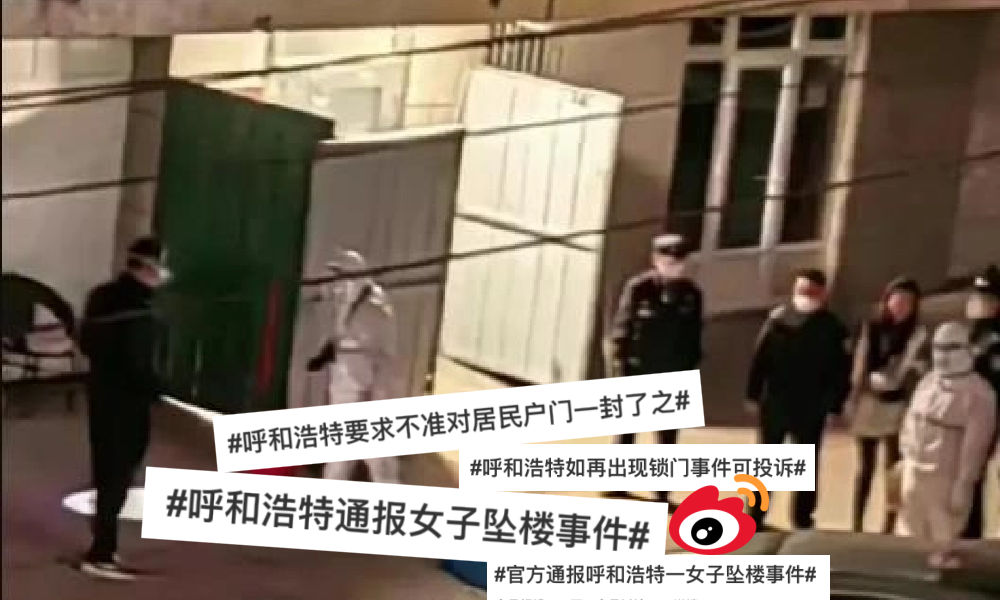
A 55-year-old woman in the city of Hohhot fell to her death from the 12th floor of her building on November 4th. The incident has become a major topic of discussion on Chinese social media, mainly because the woman’s building had fences around it with gates locked on both sides, preventing residents from leaving – even in an emergency situation.
The most-read Weibo post of this week concerns a police notice regarding an incident in Hohhot, Inner Mongolia, in which a 55-year-old female resident fell to her death from the 12th floor of her building.
The police notice, republished by China Newsweek Magazine (@中国新闻周刊), received over 1,6 million ‘likes’ and nearly 80,000 comments and over 68,000 shares. It was the number one Weibo post of the week in the Sina Weibo official top trending posts overview.
The incident happened on November 4 at Beiyuan road’s Xingguang A9 community (兴光A9小区) in the Xincheng District of Hohhot (呼和浩特市新城区). The police reportedly received a call at 18:10 that a woman had fallen from the window. They arrived at the scene at 18:15, and the emergency medical workers pronounced the woman dead shortly after.
The police urged netizens to stop sharing any videos related to the incident that circulated online.
The woman, Mrs Wang, lived together with her 29-year-old daughter at the Unit 2 building of the community. She allegedly suffered from an anxiety disorder and took prescription drugs for her condition since 2019.
Since 26 October, the community had become a ‘high-risk area’ due to two positive Covid cases, and an ‘isolation barrier’ was placed around the Unit 2 building to prevent residents from leaving the compound.
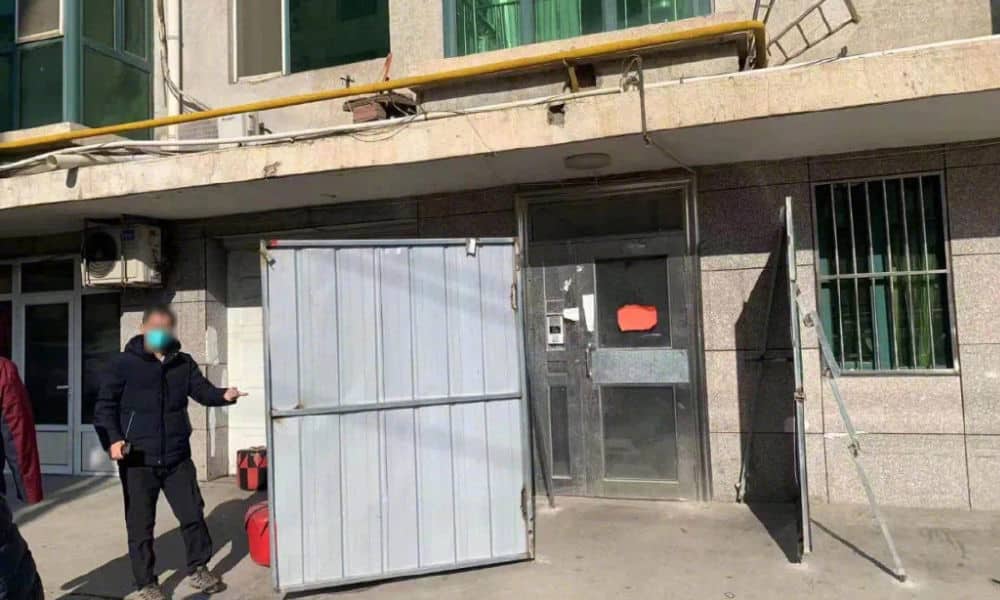
Locked-down unit with a barrier around it, photo via Lifeweek.
One reason why this particular incident has caused so much commotion on Chinese social media is that the residential building where Wang and her daughter resided was completely shut down; the gates were locked from the outside, and residents were also unable to open them from the inside. This led to a terrible situation in which Wang’s daughter was unable to rush out to get help at a critical moment, despite her banging at the doors of the gates.
News of this incident also comes at a time when several stories like this have gone trending on Chinese social media, including the incident in Ruzhou where a girl died due to a lack of medical care at a local quarantine center; and the recent case of a 3-year-old boy who suffered from carbon monoxide poisoning inside a ‘high-risk area’ with insufficient medical emergency response channels.
TIMELINE OF EVENTS
On Sunday, Hohhot’s Xincheng District authorities released a timeline detailing how the events exactly occurred on Friday, based on Wechat records and the emergency line records.
On November 4, at 10:13 in the morning, Wang’s daughter contacted the property manager Zhang X. via WeChat to report that her mother was having a mental breakdown.
She contacted Zhang at 17:13 again to report that her mother’s condition had worsened and that she was showing suicidal behavior. When asking if Zhang could call the emergency hotline, she was reportedly told “call them yourself, I’m busy.”
At 17:23, the eldest daughter of Wang, a 35-year-old resident of Hainan, contacted the emergency hotline on behalf of her sister, because the sisters allegedly were afraid that their mother’s condition would further deteriorate if the hotline was contacted in their mother’s presence. The dispatcher team, however, decided that the case was a non-emergency one and the case was temporarily put on hold.
At 17:31, as the situation was not improving at all, Wang’s second daughter called for an ambulance and notified the property management to arrange for community workers to get ready to meet the ambulance staff at the community gate.
Zhang X. arranged for property management staff member Wu X. to meet the ambulance and the main community gate, and then allegedly also reported the case to the residential complex staff member in charge, who seemingly failed to forward the message to the relevant workers at the scene. Not a single member of staff came to check on Wang and her daughter at their apartment.
At 18:04, Mrs Wang fell from the bedroom window of her apartment on the 12th floor of the building. Just moments before, her daughter had gone into the living room to charge her phone.
Several calls came in at the emergency hotlines in the following minutes about the woman falling from the window.
At 18:10, a local staff member could hear someone – Wang’s daughter – shouting and banging from the other side of the isolation barrier. When the gate of the barrier was opened, they found the person had gone back inside.
At 18:14, Wang’s daughter contacted the property manager and asked them to open up the barrier gates.
By 18:15, first responders had arrived at the scene and were let into the community gates, finding the daughter sitting by her deceased mother’s body.

Mrs Wang was officially pronounced dead at 18:39. Her remains were transported to the morgue at 20:22.
The Hohhot Xincheng District extended their condolences to the Wang family and admitted that their local emergency response system was lagging behind and that the situation was poorly handled by the property management and residential area staff.
The district authorities stated they would strengthen their emergency response system and would hold those who mismanaged the situation accountable in accordance with the law.
INSIDE THE LOCKED-DOWN UNITS
Over the weekend, flowers piled up outside the gate of the Xingguang A9 community.
Chinese media outlet Lifeweek (三联生活周刊) published a story and several interviews on 6 November, using the hashtag “Life Behind the Doors of the Locked-down Units” (#封闭在单元门背后的生活#).
Lifeweek reporters spoke to neighbors living in Unit 2 of Xingguang A9 as well as other people in the neighbourhood.
They confirmed that virtually all buildings that were deemed ‘high risk’ – and sometimes some labeled as lower risk – had been shut off from the outside world, leaving residents unable to leave. The gates were locked from both the outside and the inside, as was the case with Xingguang A9.
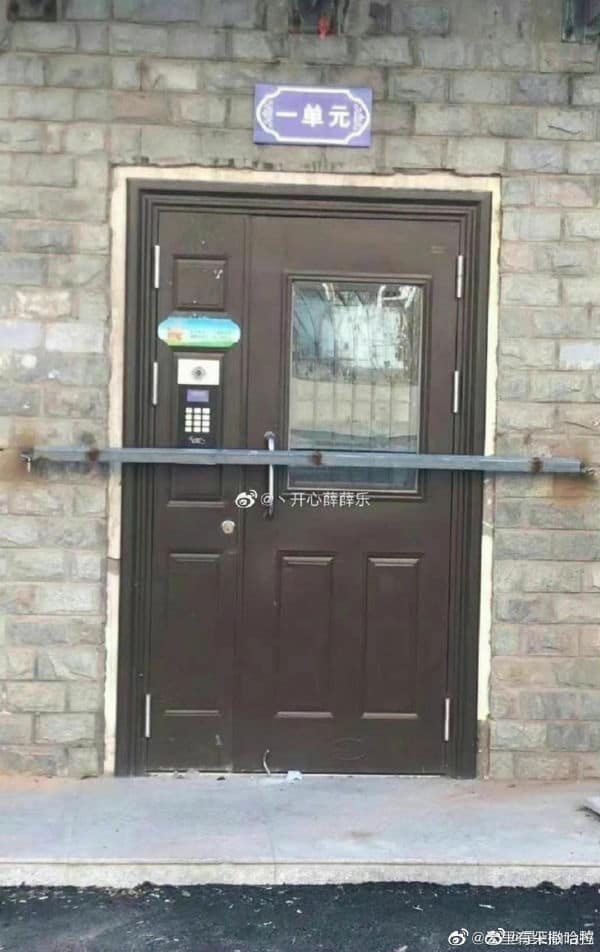
Example of a local unit being locked, leaving residents unable to leave (this is not Unit 2).
“This just makes my blood run cold,” some commenters said on Weibo, where many people expressed anger about the incident and also about how it was presented by several state media outlets: they focused on the woman falling from the window rather than the fact that the building was locked down.
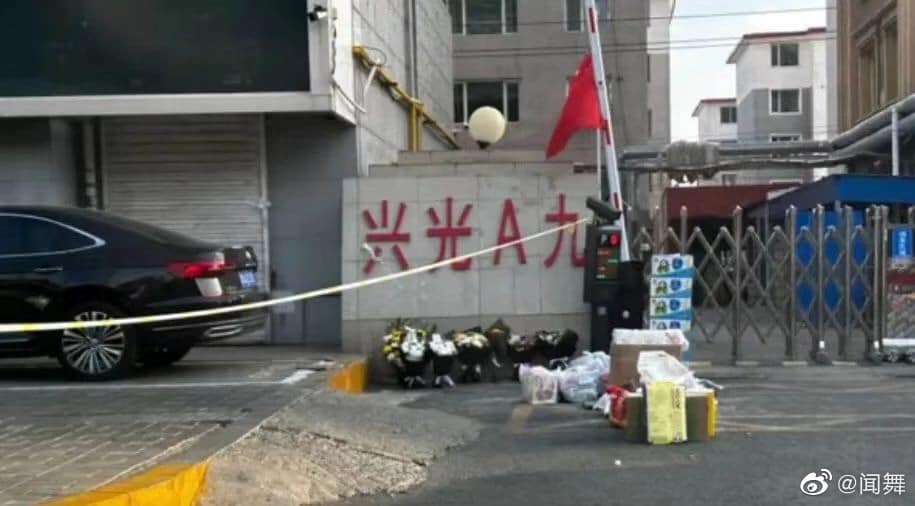
Flowers outside the community, photo originally published by Lifeweek.
In light of the incident, Hohhot’s local epidemic prevention authorities released an official statement regarding Covid-19 lockdown measures. Locking residents inside their building is not allowed, authorities said, emphasizing that emergency and escape routes should always be kept clear of all obstructions and that community gates should never be locked.
Although it is still allowed to close the doors of a building and to set up isolation fences, they can only be closed with a seal that can be broken in case of an emergency. Closing the door with locks, pins, bars, etc is not allowed.
Despite the promises of improvement, some commenters online are pessimistic about what this winter will bring: “Looking at Xinjiang, Hohhot, this virus is being mismanaged and all that we’re facing this winter is the fight against the epidemic. Otherwise they’ll have to change the policies. The consequences are unthinkable.”
On Douyin (TikTok), various unverified videos show unethical lockdown measures, with doors being locked with chains and bars, in light of what happened in Hohhot.
The censorship that comes with topics such as these is also not reassuring to many: “They’ve put on comment filtering again. The comments on display are monotone and actually reveal what they want to hide.”
“I beg you, give us a way out,” one Weibo user wrote.
Many commenters expressed that they do not necessarily oppose China’s fight against Covid, but that they just oppose “excessive anti-epidemic measures.”
One popular Douyin comment said: “How many more sacrifices do we need to bring before you wake up?”
By Manya Koetse, with contributions by Miranda Barnes
Follow @WhatsOnWeibo
For information and support on mental health and suicide, international helplines can be found at www.befrienders.org.
Get the story behind the hashtag. Subscribe to What’s on Weibo here to receive our newsletter and get access to our latest articles:
Spotted a mistake or want to add something? Please let us know in comments below or email us. First-time commenters, please be patient – we will have to manually approve your comment before it appears.
©2022 Whatsonweibo. All rights reserved. Do not reproduce our content without permission – you can contact us at info@whatsonweibo.com.
Manya Koetse is the founder and editor-in-chief of whatsonweibo.com. She is a writer, public speaker, and researcher (Sinologist, MPhil) on social trends, digital developments, and new media in an ever-changing China, with a focus on Chinese society, pop culture, and gender issues. She shares her love for hotpot on hotpotambassador.com. Contact at manya@whatsonweibo.com, or follow on Twitter.

Also Read
China and Covid19
Sick Kids, Worried Parents, Overcrowded Hospitals: China’s Peak Flu Season on the Way
“Besides Mycoplasma infections, cases include influenza, Covid-19, Norovirus, and Adenovirus. Heading straight to the hospital could mean entering a cesspool of viruses.”
Published
8 months agoon
November 22, 2023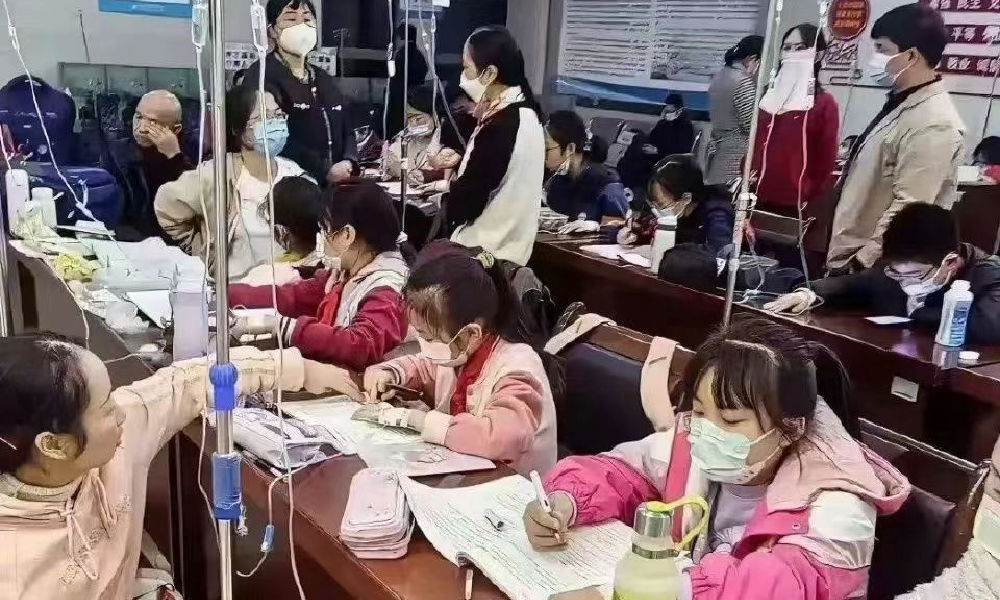
In the early morning of November 21, parents are already queuing up at Xi’an Children’s Hospital with their sons and daughters. It’s not even the line for a doctor’s appointment, but rather for the removal of IV needles.
The scene was captured in a recent video, only one among many videos and images that have been making their rounds on Chinese social media these days (#凌晨的儿童医院拔针也要排队#).
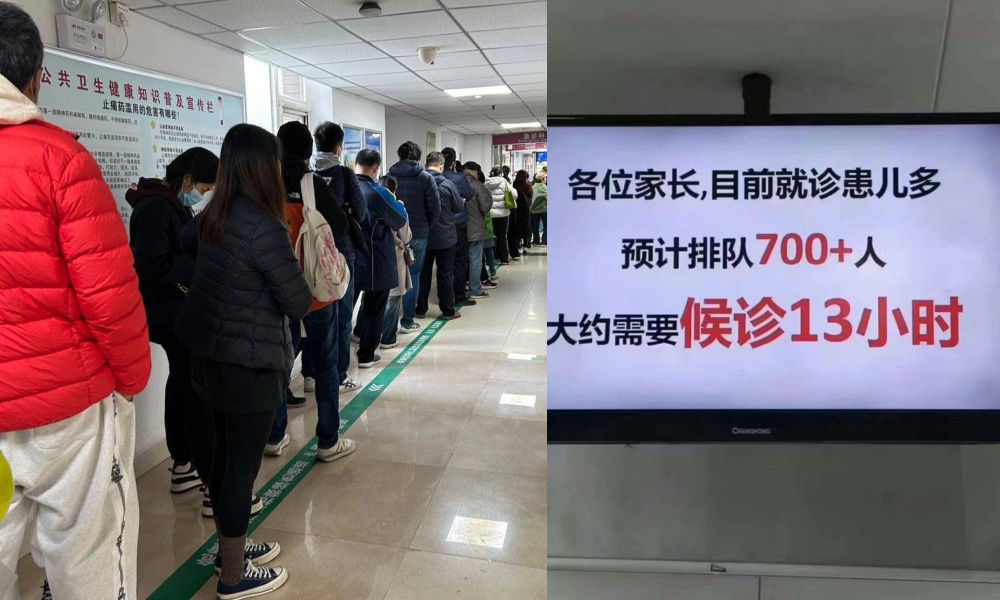
One photo shows a bulletin board at a local hospital warning parents that over 700 patients are waiting in line, estimating a waiting time of more than 13 hours to see a doctor.
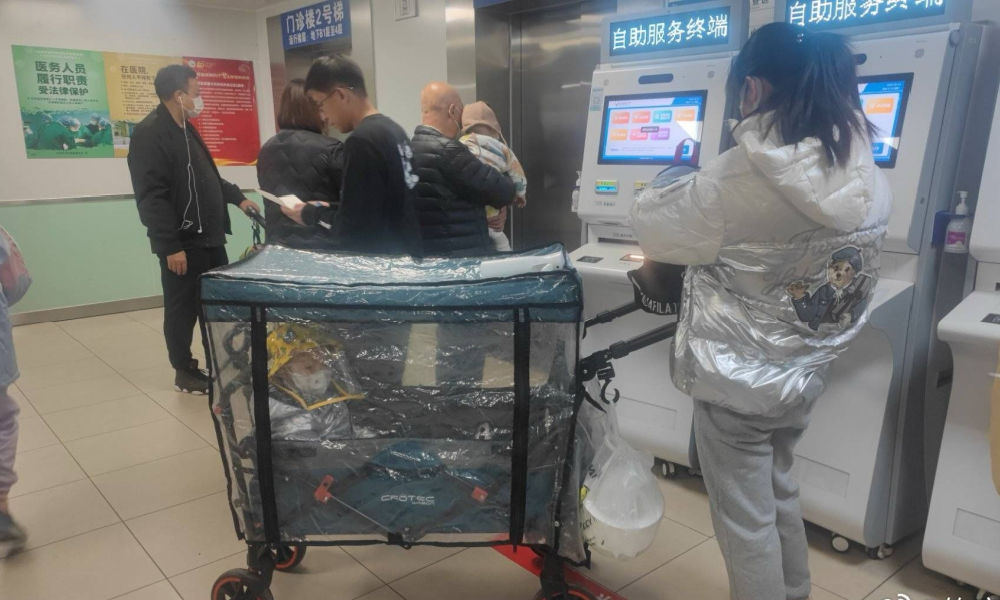
Another image shows children doing their homework while hooked up on an IV.
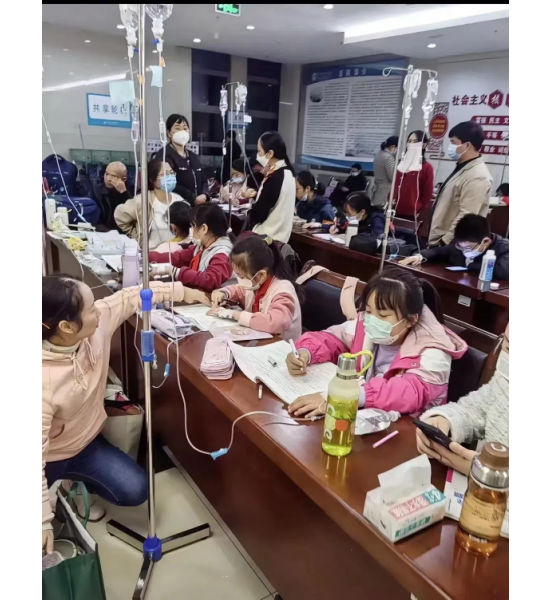
Recent discussions on Chinese social media platforms have highlighted a notable surge in flu cases. The ongoing flu season is particularly impacting children, with multiple viruses concurrently circulating and contributing to a high incidence of respiratory infections.
Among the prevalent respiratory infections affecting children are Mycoplasma pneumoniae infections, influenza, and Adenovirus infection.
The spike in flu cases has resulted in overcrowded children’s hospitals in Beijing and other Chinese cities. Parents sometimes have to wait in line for hours to get an appointment or pick up medication.
According to one reporter at Haibao News (海报新闻), there were so many patients at the Children’s Hospital of Capital Institute of Pediatrics (首都儿科研究所) on November 21st that the outpatient desk stopped accepting new patients by the afternoon. Meanwhile, 628 people were waiting in line to see a doctor at the emergency department.
Reflecting on the past few years, the current flu season marks China’s first ‘normal’ flu peak season since the outbreak of Covid-19 in late 2019 / early 2020 and the end of its stringent zero-Covid policies in December 2022. Compared to many other countries, wearing masks was also commonplace for much longer following the relaxation of Covid policies.
Hu Xijin, the well-known political commentator, noted on Weibo that this year’s flu season seems to be far worse than that of the years before. He also shared that his own granddaughter was suffering from a 40 degrees fever.
“We’re all running a fever in our home. But I didn’t dare to go to the hospital today, although I want my child to go to the hospital tomorrow. I heard waiting times are up to five hours now,” one Weibo user wrote.
“Half of the kids in my child’s class are sick now. The hospital is overflowing with people,” another person commented.
One mother described how her 7-year-old child had been running a fever for eight days already. Seeking medical attention on the first day, the initial diagnosis was a cold. As the fever persisted, daily visits to the hospital ensued, involving multiple hours for IV fluid administration.
While this account stems from a single Weibo post within a fever-advice community, it highlights a broader trend: many parents swiftly resort to hospital visits at the first signs of flu or fever. Several factors contribute to this, including a lack of General Practitioners in China, making hospitals the primary choice for medical consultations also in non-urgent cases.
There is also a strong belief in the efficacy of IV infusion therapy, whether fluid-based or containing medication, as the quickest path to recovery. Multiple factors contribute to the widespread and sometimes irrational use of IV infusions in China. Some clinics are profit-driven and see IV infusions as a way to make more money. Widespread expectations among Chinese patients that IV infusions will make them feel better also play a role, along with some physicians’ lacking knowledge of IV therapy or their uncertainty to distinguish bacterial from viral infections (read more here)
To prevent an overwhelming influx of patients to hospitals, Chinese state media, citing specialists, advise parents to seek medical attention at the hospital only for sick infants under three months old displaying clear signs of fever (with or without cough). For older children, it is recommended to consult a doctor if a high fever persists for 3 to 5 days or if there is a deterioration in respiratory symptoms. Children dealing with fever and (mild) respiratory symptoms can otherwise recover at home.
One Weibo blogger (@奶霸知道) warned parents that taking their child straight to the hospital on the first day of them getting sick could actually be a bad idea. They write:
“(..) pediatric departments are already packed with patients, and it’s not just Mycoplasma infections anymore. Cases include influenza, Covid-19, Norovirus, and Adenovirus. And then, of course, those with bad luck are cross-infected with multiple viruses at the same time, leading to endless cycles. Therefore, if your child experiences mild coughing or a slight fever, consider observing at home first. Heading straight to the hospital could mean entering a cesspool of viruses.”
The hashtag for “fever” saw over 350 million clicks on Weibo within one day on November 22.
Meanwhile, there are also other ongoing discussions on Weibo surrounding the current flu season. One topic revolves around whether children should continue doing their homework while receiving IV fluids in the hospital. Some hospitals have designated special desks and study areas for children.
Although some commenters commend the hospitals for being so considerate, others also remind the parents not to pressure their kids too much and to let them rest when they are not feeling well.
Opinions vary: although some on Chinese social media say it's very thoughtful for hospitals to set up areas where kids can study and read, others blame parents for pressuring their kids to do homework at the hospital instead of resting when not feeling well. pic.twitter.com/gnQD9tFW2c
— Manya Koetse (@manyapan) November 22, 2023
By Manya Koetse, with contributions from Miranda Barnes
Get the story behind the hashtag. Subscribe to What’s on Weibo here to receive our newsletter and get access to our latest articles:
Spotted a mistake or want to add something? Please let us know in comments below or email us. First-time commenters, please be patient – we will have to manually approve your comment before it appears.
©2023 Whatsonweibo. All rights reserved. Do not reproduce our content without permission – you can contact us at info@whatsonweibo.com.
China and Covid19
Repurposing China’s Abandoned Nucleic Acid Booths: 10 Innovative Transformations
Abandoned nucleic acid booths are getting a second life through these new initiatives.
Published
1 year agoon
May 19, 2023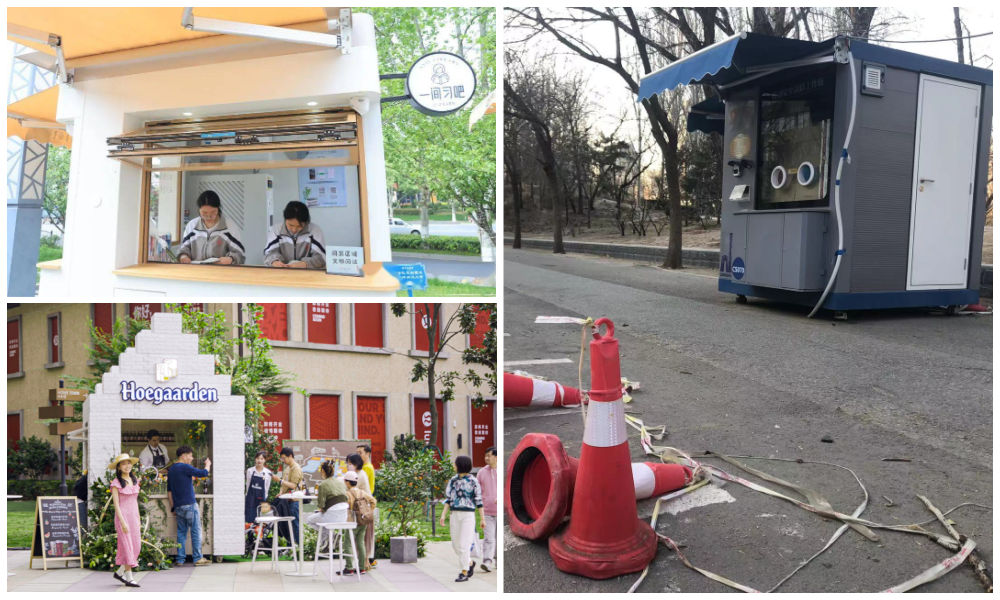
During the pandemic, nucleic acid testing booths in Chinese cities were primarily focused on maintaining physical distance. Now, empty booths are being repurposed to bring people together, serving as new spaces to serve the community and promote social engagement.
Just months ago, nucleic acid testing booths were the most lively spots of some Chinese cities. During the 2022 Shanghai summer, for example, there were massive queues in front of the city’s nucleic acid booths, as people needed a negative PCR test no older than 72 hours for accessing public transport, going to work, or visiting markets and malls.
The word ‘hésuān tíng‘ (核酸亭), nucleic acid booth (also:核酸采样小屋), became a part of China’s pandemic lexicon, just like hésuān dìtú (核酸地图), the nucleic acid test map lauched in May 2022 that would show where you can get a nucleic test.
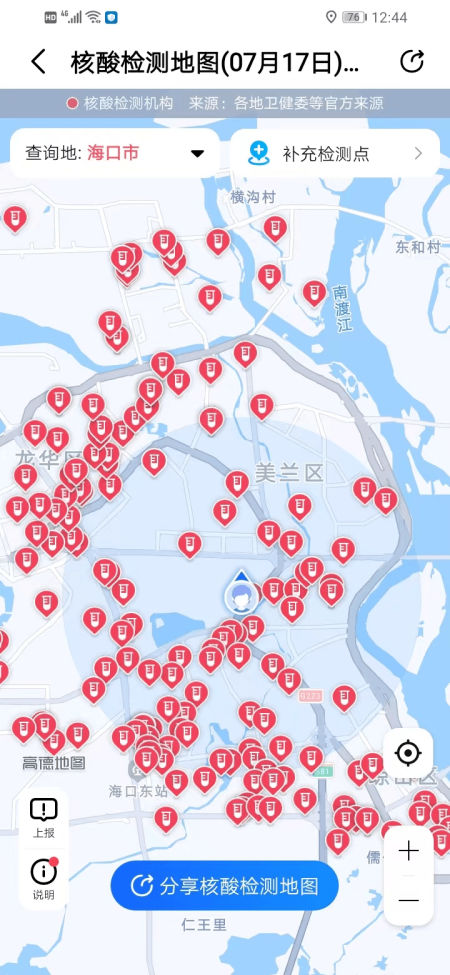
Example of nucleic acid test map.
During Halloween parties in Shanghai in 2022, some people even came dressed up as nucleic test booths – although local authorities could not appreciate the creative costume.
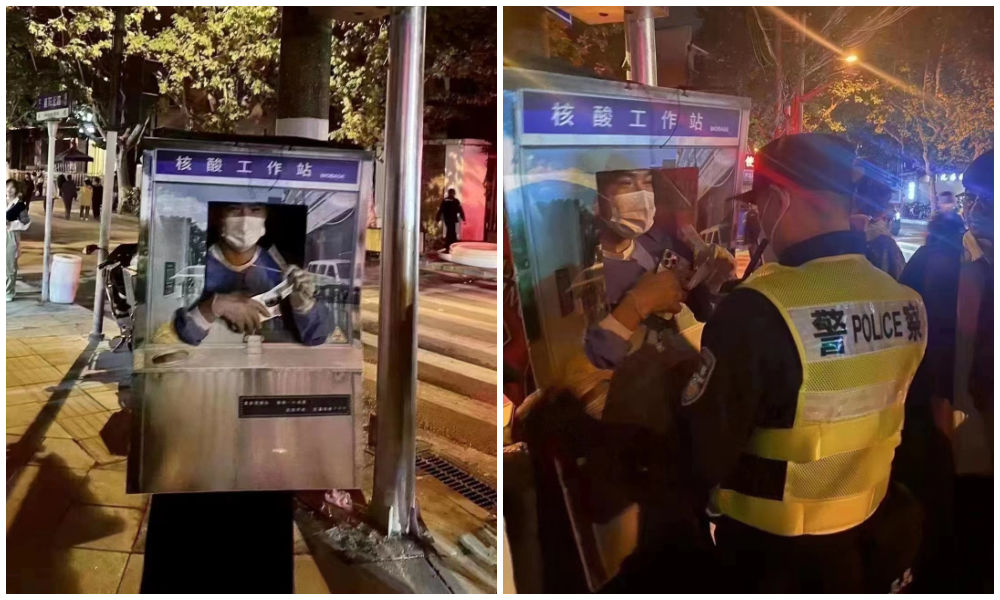
Halloween 2022: dressed up as nucliec acid booths. Via @manyapan twitter.
In December 2022, along with the announced changed rules in China’s ‘zero Covid’ approach, nucleic acid booths were suddenly left dismantled and empty.
With many cities spending millions to set up these booths in central locations, the question soon arose: what should they do with the abandoned booths?
This question also relates to who actually owns them, since the ownership is mixed. Some booths were purchased by authorities, others were bought by companies, and there are also local communities owning their own testing booths. Depending on the contracts and legal implications, not all booths are able to get a new function or be removed yet (Worker’s Daily).
In Tianjin, a total of 266 nucleic acid booths located in Jinghai District were listed for public acquisition earlier this month, and they were acquired for 4.78 million yuan (US$683.300) by a local food and beverage company which will transform the booths into convenience service points, selling snacks or providing other services.
Tianjin is not the only city where old nucleic acid testing booths are being repurposed. While some booths have been discarded, some companies and/or local governments – in cooperation with local communities – have demonstrated creativity by transforming the booths into new landmarks. Since the start of 2023, different cities and districts across China have already begun to repurpose testing booths. Here, we will explore ten different way in which China’s abandoned nucleic test booths get a second chance at a meaningful existence.
1: Pharmacy/Medical Booths
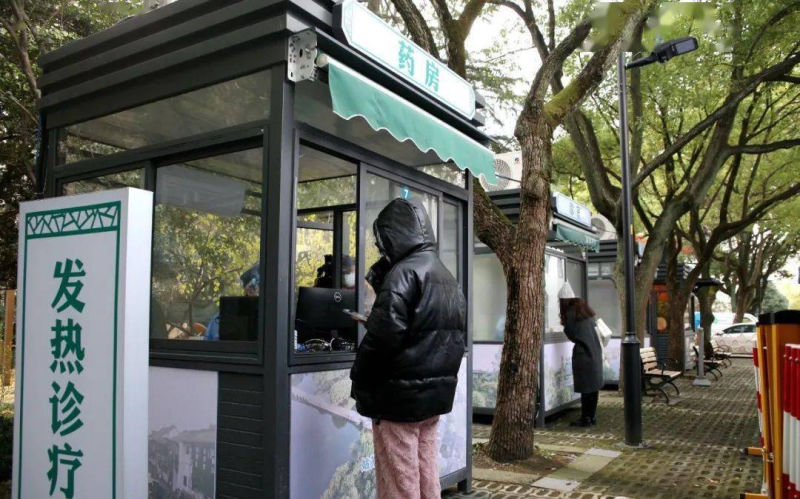
Via ‘copyquan’ republished on Sohu.
Blogger ‘copyquan’ recently explored various ways in which abandoned PCR testing points are being repurposed.
One way in which they are used is as small pharmacies or as medical service points for local residents (居民医疗点). Alleviating the strain on hospitals and pharmacies, this was one of the earliest ways in which the booths were repurposed back in December of 2022 and January of 2023.
Chongqing, Tianjin, and Suzhou were among earlier cities where some testing booths were transformed into convenient medical facilities.
2: Market Stalls
In Suzhou, Jiangsu province, the local government transformed vacant nucleic acid booths into market stalls for the Spring Festival in January 2022, offering them free of charge to businesses to sell local products, snacks, and traditional New Year goods.
The idea was not just meant as a way for small businesses to conveniently sell to local residents, it was also meant as a way to attract more shoppers and promote other businesses in the neighborhood.
3: Community Service Center
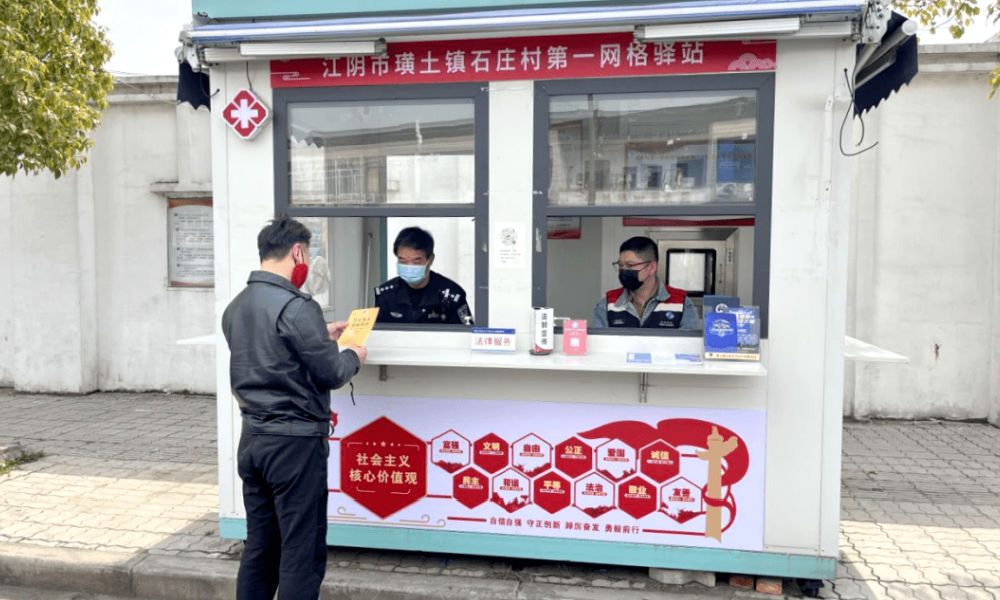
Small grid community center in Shizhuang Village, image via Sohu.
Some residential areas have transformed their local nucleic acid testing booths into community service centers, offering all kinds of convenient services to neighborhood residents.
These little station are called wǎnggé yìzhàn (网格驿站) or “grid service stations,” and they can serve as small community centers where residents can get various kinds of care and support.
4: “Refuel” Stations
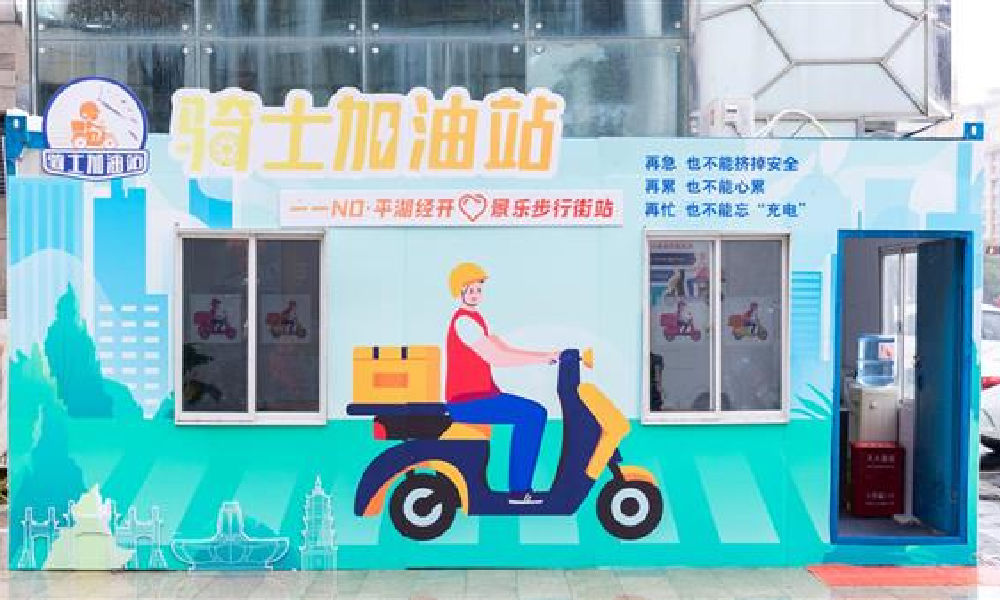
In February of this year, 100 idle nucleic acid sampling booths were transformed into so-called “Rider Refuel Stations” (骑士加油站) in Zhejiang’s Pinghu. Although it initially sounds like a place where delivery riders can fill up their fuel tanks, it is actually meant as a place where they themselves can recharge.
Delivery riders and other outdoor workers can come to the ‘refuel’ station to drink some water or tea, warm their hands, warm up some food and take a quick nap.
5: Free Libraries
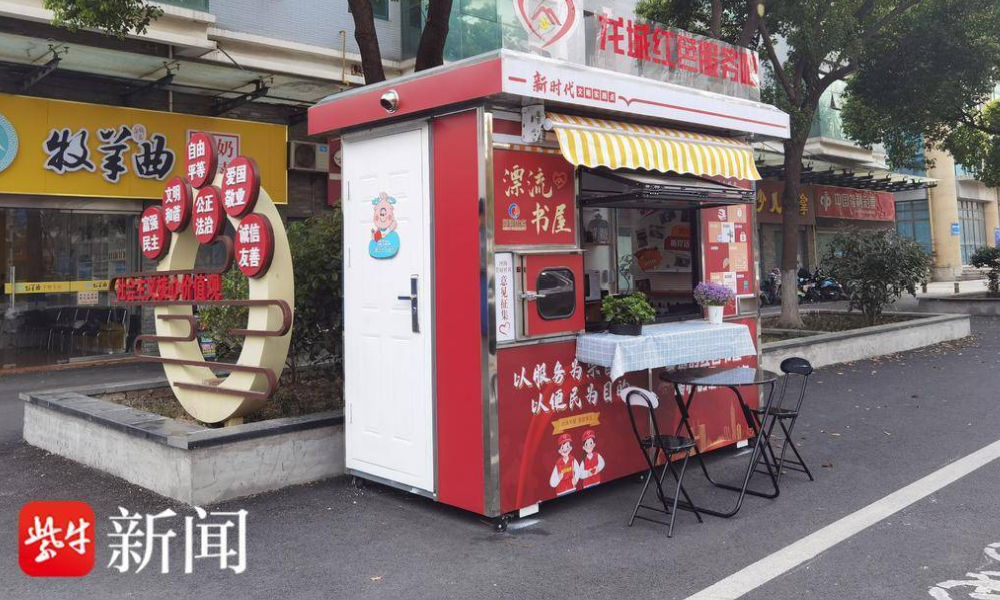
image via sohu.
In various Chinese cities, abandoned nucleic acid booths have been transformed into little free libraries where people can grab some books to read, donate or return other books, and sit down for some reading.
Changzhou is one of the places where you’ll find such “drifting bookstores” (漂流书屋) (see video), but similar initiatives have also been launched in other places, including Suzhou.
6: Study Space
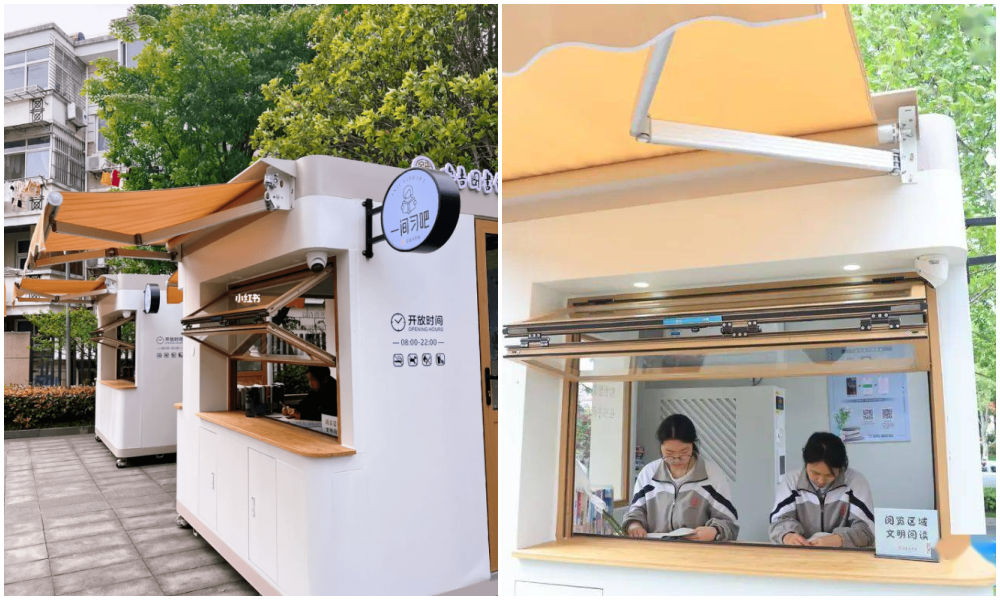
Photos via Copyquan’s article on Sohu.
Another innovative way in which old testing points are being repurposed is by turning them into places where students can sit together to study. The so-called “Let’s Study Space” (一间习吧), fully airconditioned, are opened from 8 in the morning until 22:00 at night.
Students – or any citizens who would like a nice place to study – can make online reservations with their ID cards and scan a QR code to enter the study rooms.
There are currently ten study booths in Anji, and the popular project is an initiative by the Anji County Library in Zhejiang (see video).
7: Beer Kiosk
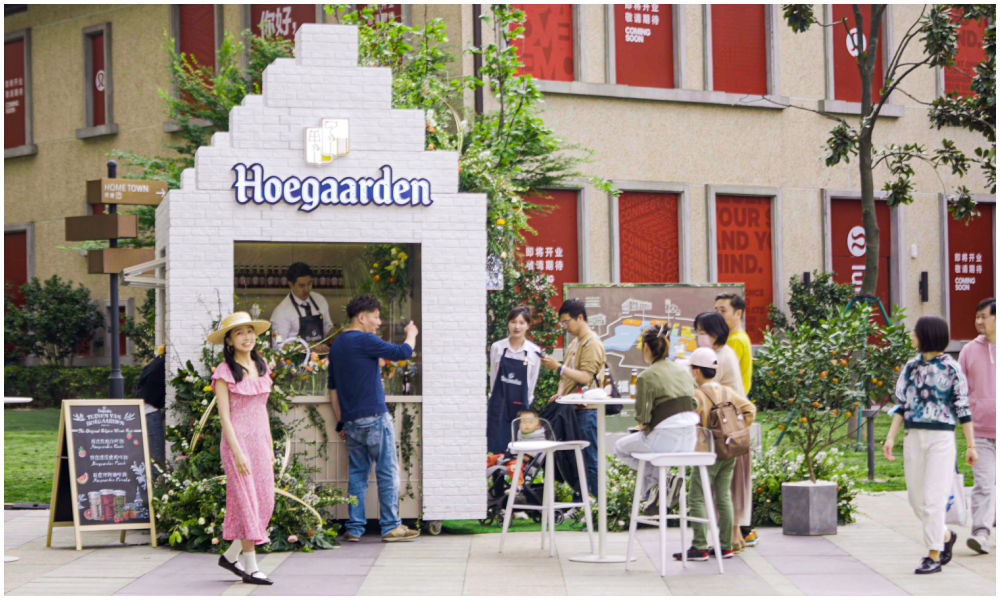
Hoegaarden beer shop, image via Creative Adquan.
Changing an old nucleic acid testing booth into a beer bar is a marketing initiative by the Shanghai McCann ad agency for the Belgium beer brand Hoegaarden.
The idea behind the bar is to celebrate a new spring after the pandemic. The ad agency has revamped a total of six formr nucleic acid booths into small Hoegaarden ‘beer gardens.’
8: Police Box
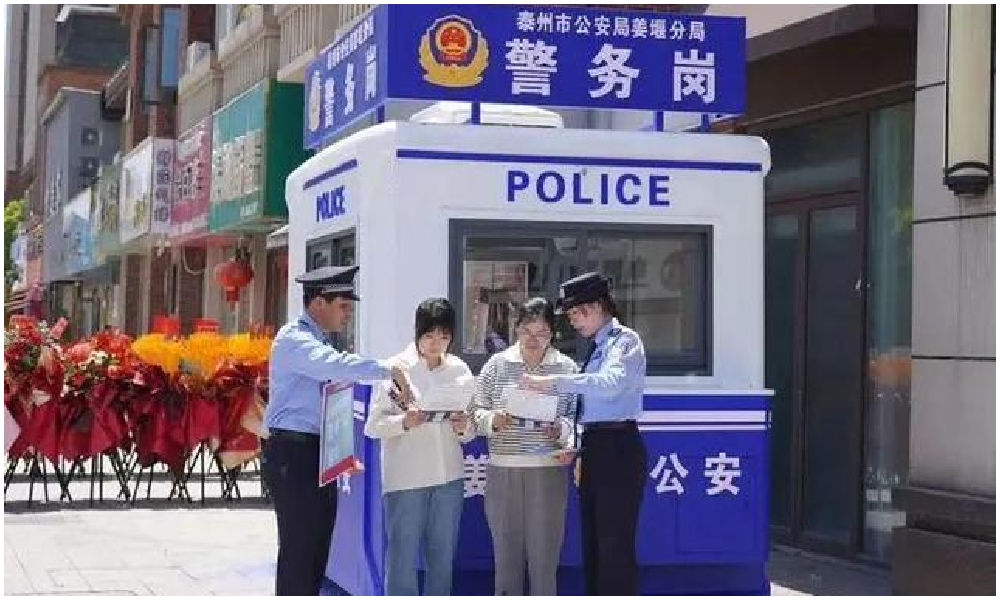
In Taizhou City, Jiangsu Province, authorities have repurposed old testing booths and transformed them into ‘police boxes’ (警务岗亭) to enhance security and improve the visibility of city police among the public.
Currently, a total of eight vacant nucleic acid booths have been renovated into modern police stations, serving as key points for police presence and interaction with the community.
9: Lottery Ticket Booths
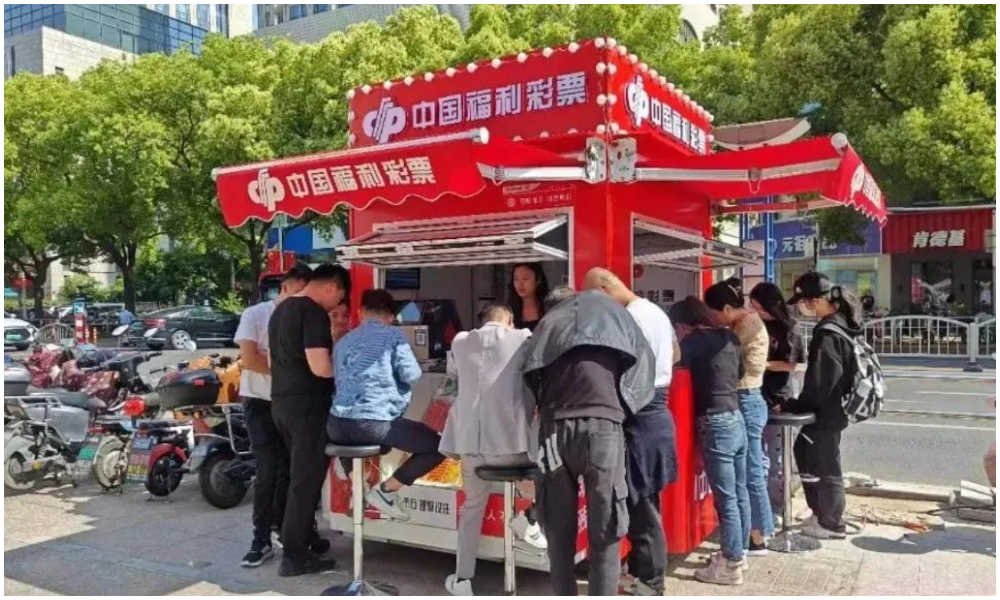
Image via The Paper
Some nucleic acid booths have now been turned into small shops selling lottery tickets for the China Welfare Lottery. One such place turning the kiosks into lottery shops is Songjiang in Shanghai.
Using the booths like this is a win-win situation: they are placed in central locations so it is more convenient for locals to get their lottery tickets, and on the other hand, the sales also help the community, as the profits are used for welfare projects, including care for the elderly.
10: Mini Fire Stations
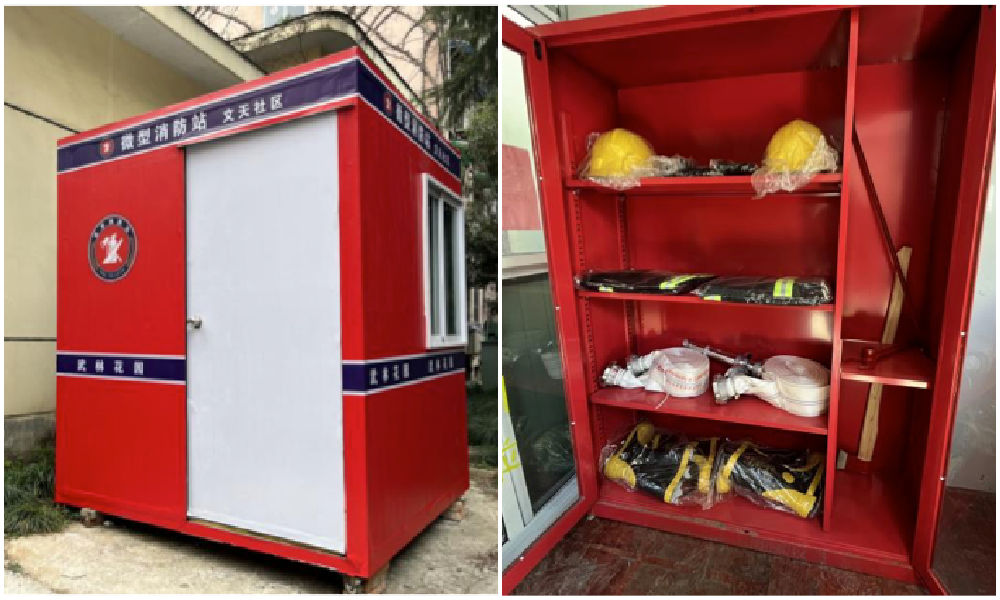
Micro fire stations, images via ZjNews.
Some communities decided that it would be useful to repurpose the testing points and turn them into mini fire kiosks, just allowing enough space for the necessary equipment to quickly respond to fire emergencies.
Want to read more about the end of ‘zero Covid’ in China? Check our other articles here.
By Manya Koetse,
Get the story behind the hashtag. Subscribe to What’s on Weibo here to receive our newsletter and get access to our latest articles:
Spotted a mistake or want to add something? Please let us know in comments below or email us. First-time commenters, please be patient – we will have to manually approve your comment before it appears.
©2023 Whatsonweibo. All rights reserved. Do not reproduce our content without permission – you can contact us at info@whatsonweibo.com.
Subscribe

Weibo Watch: The Future is Here

“Bye Bye Biden”: Biden’s Many Nicknames in Chinese

Enjoying the ‘Sea’ in Beijing’s Ditan Park

A Triumph for “Comrade Trump”: Chinese Social Media Reactions to Trump Rally Shooting

Weibo Watch: Get Up, Stand Up

The Tragic Story of “Fat Cat”: How a Chinese Gamer’s Suicide Went Viral

“Old Bull Eating Young Grass”: 86-Year-Old Chinese Painter Fan Zeng Marries 36-Year-Old Xu Meng

A Brew of Controversy: Lu Xun and LELECHA’s ‘Smoky’ Oolong Tea

Singing Competition or Patriotic Fight? Hunan TV’s ‘Singer 2024’ Stirs Nationalistic Sentiments

Zara Dress Goes Viral in China for Resemblance to Haidilao Apron

Weibo Watch: The Battle for the Bottom Bed

About the “AI Chatbot Based on Xi Jinping” Story

China’s Intensified Social Media Propaganda: “Taiwan Must Return to Motherland”

Weibo Watch: Telling China’s Stories Wrong

Saying Goodbye to “Uncle Wang”: Wang Wenbin Becomes Chinese Ambassador to Cambodia
Get in touch
Would you like to become a contributor, or do you have any tips or suggestions? Get in touch here!
Popular Reads
-

 China Insight3 months ago
China Insight3 months agoThe Tragic Story of “Fat Cat”: How a Chinese Gamer’s Suicide Went Viral
-

 China Music4 months ago
China Music4 months agoThe Chinese Viral TikTok Song Explained (No, It’s Not About Samsung)
-

 China Digital10 months ago
China Digital10 months agoToo Sexy for Weibo? Online Discussions on the Concept of ‘Cābiān’
-

 China Arts & Entertainment12 months ago
China Arts & Entertainment12 months agoBehind 8 Billion Streams: Who is Dao Lang Cursing in the Chinese Hit Song ‘Luocha Kingdom’?




